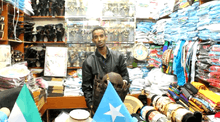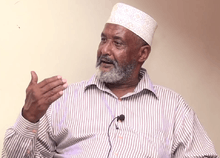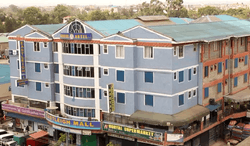Somalis in Kenya
| Total population | |
|---|---|
| 2,385,572 (2009 census)[1] | |
| Regions with significant populations | |
| North Eastern Province · Nairobi · Mombasa | |
| Languages | |
|
Somali (mother tongue) Arabic (second language) English, Swahili (working languages) | |
| Religion | |
| Islam |
Somalis in Kenya are citizens and residents of Kenya who are of Somali descent. They have historically inhabited the Northern Frontier District (North Eastern Province), which was carved out of the Jubaland region of present-day southern Somalia during the colonial period. Following the civil war in Somalia that broke out in 1991, many Somalis sought asylum in the Somali-inhabited enclaves of Kenya. An entrepreneurial community, they established themselves in the business sector, particularly in the Nairobi suburb of Eastleigh.
Population
According to the 2009 Kenya census, approximately 2,385,572 ethnic Somalis live in Kenya.[1] Among these individuals are a number of ethnically Somali international migrants, around 300,000 of whom inhabit the wider East and South Africa regions.[2] These ethnic Somalis are distinct from the Bantus and other minorities of Somalia, who according to USAID constitute most of the estimated 413,170 refugees from Somalia in Kenya.[3][4]
SIL Ethnologue reports a breakdown of the Somali population in Kenya from the 1989 census, consisting of 312,339 individuals. Of the latter, 45,098 were from unspecified Somali clans, 27,244 from the Murule clan, 100,400 from the Degodia clan, and 139,597 from the Ogaden clan.[5]
History
Somalis in Kenya have historically inhabited the Northern Frontier District (NFD), later renamed the North Eastern Province. The NFD came into being in 1925, when it was carved out of the Jubaland region in present-day southern Somalia.[6] At the time under British colonial administration, the northern half of Jubaland was ceded to Italy as a reward for the Italians' support of the Allies during World War I.[7] Britain retained control of the southern half of the territory, which was later called the Northern Frontier District.[6]
On 26 June 1960, four days before granting British Somaliland independence, the British government declared that all Somali-inhabited areas of East Africa should be unified in one administrative region. However, after the dissolution of the former British colonies in the region, Britain granted administration of the Northern Frontier District to Kenyan nationalists. This was despite an informal plebiscite demonstrating the overwhelming desire of the region's population to join the newly formed Somali Republic,[8] and the fact that the NFD was almost exclusively inhabited by ethnic Somalis.[9][10][11] Nonetheless, the Somali residents had by then successfully lobbied for a separate classification from the adjacent Bantu and Nilotic populations. In the 1962 British Kenya census, the Somali expatriates were accorded their own "Somali" entry separate from the "African", "Arab", "Asian" and "European" designations.[12]

On the eve of Kenya's independence in August 1963, British officials belatedly realized that the new Kenyan regime was not willing to give up the Somali-inhabited areas it had just been granted administration of. Led by the Northern Province People's Progressive Party (NPPPP), Somalis in the NFD vigorously sought union with their kin in the Somali Republic to the north.[13] In response, the Kenyan government enacted a number of repressive measures designed to frustrate their efforts in what came to be known as the Shifta War.[14] Although the conflict ended in a cease-fire, Somalis in the region still identify and maintain close ties with their brethren in Somalia.[15] They have traditionally married within their own community and formed a cohesive ethnic network.[16]

Following the civil war in Somalia that broke out in 1991, many Somalis sought asylum in the Somali-inhabited enclaves in Kenya. An entrepreneurial community, they established themselves in the business sector,[17] investing over $1.5 billion in Eastleigh alone.[18] Starting in late 2012, a mass exodus of Somali residents was reported after a prolonged period of harassment by the Kenyan police and public. Hundreds of Somali entrepreneurs withdrew between Sh10 to Sh40 billion from their bank accounts, with the intention of reinvesting most of that money back home in Somalia. The collective departures most affected Eastleigh's real estate sector, as landlords struggled to find Kenyans able to afford the high rates of the apartments and shops vacated by the Somalis.[19]
See also
References
- 1 2 "2009 POPULATION & HOUSING CENSUS RESULTS" (PDF). Ministry of State for Planning, National Development and Vision 2030. Archived from the original on 15 January 2013. Retrieved 17 September 2014.
- ↑ Shire, Saad A. "92 Transactions with Homeland: Remittance". Bildhaan. Retrieved 19 June 2016.
- ↑ "Somalia Humanitarian Situation Update". Wikileaks. USAID. Retrieved 19 June 2016.
- ↑ "Registered Somali Refugee Population". UNHCR. Retrieved 19 June 2016.
- ↑ "Kenya". Ethnologue. Retrieved 5 March 2017.
- 1 2 Osman, Mohamed Amin AH (1993). Somalia, proposals for the future. SPM. pp. 1–10.
- ↑ Oliver, Roland Anthony (1976). History of East Africa, Volume 2. Clarendon Press. p. 7.
- ↑ David D. Laitin, Politics, Language, and Thought: The Somali Experience, (University Of Chicago Press: 1977), p.75
- ↑ Africa Watch Committee, Kenya: Taking Liberties, (Yale University Press: 1991), p.269
- ↑ Women's Rights Project, The Human Rights Watch Global Report on Women's Human Rights, (Yale University Press: 1995), p.121
- ↑ Francis Vallat, First report on succession of states in respect of treaties: International Law Commission twenty-sixth session 6 May-26 July 1974, (United Nations: 1974), p.20
- ↑ "Kenya Population Census, 1962 – Appendix 1" (PDF). Government of Kenya. Retrieved 22 December 2015.
- ↑ Bruce Baker, Escape from Domination in Africa: Political Disengagement & Its Consequences, (Africa World Press: 2003), p.83
- ↑ Rhoda E. Howard, Human Rights in Commonwealth Africa, (Rowman & Littlefield Publishers, Inc.: 1986), p.95
- ↑ Godfrey Mwakikagile, Kenya: identity of a nation, (Godfrey Mwakikagile: 2007), p.79.
- ↑ Jomo Kenyatta University of Agriculture and Technology. Research Production and Extension Division (2006). Proceedings of 2005 JKUAT Scientific, Technological, and Industrialisation Conference: "leveraging indigenous products and technologies through research for industrialisation and development" : 27th-28th October, 2005. Jomo Kenyatta University of Agriculture and Technology, Research Production and Extension Division. p. 27. ISBN 9966923284.
- ↑ Kenya/Somalia: Somalia community doing booming business in country Archived 16 February 2011 at the Wayback Machine.
- ↑ Help Locals Rebuild Their Country By Ensuring World Attention And Peace
- ↑ Mohammed, Guled (9 January 2013). "Kenya: The Cost of Harassing Somalis Over Terror". The Star. Retrieved 13 January 2013.
